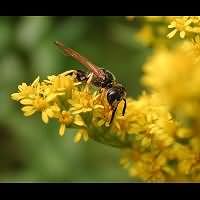Bee Wolf Philanthus triangulum
The Bee Wolf is among the very few Digger Wasps having a well known common English name. It is a rather big, slender Digger Wasp. The basic colour is black, but there are extensive, but variable yellow markings. Usually the face is all yellow. The head of the females is bigger, broader and stronger than the male's. Males are smaller too, reaching a length of some 8 to 15mm. Females may be 12 to 17mm long.
The nests of the Bee Wolf are remarkable. The entrance is slightly downwards, but soon runs horizontally for some 100cm, untill it turns sharply and ends in three to over thirty cells. The prey for the larvae exists of Honey Bees, of which three to six animals are stored per cell. Every now and then another species is gathered, always solitary bees. The prey is usually attacked from the air while eating nectar or pollen from a flower. The Bee Wolf often lives in smaller or bigger colonies, but there is always a certain distance between the entrances. It has been discovered recently that a gland near the antenna produces a signalling substance. The mother Bee Wolf uses this to mark the spot where her off spring should start digging to get out of the cell. The Bee Wolf enjoys the company of many parasites, such as the Cuckoo Wasp Hedychrum rutilans, some Flesh Flies and the curiously shaped Blow Flies of the genus Conops. Metopia-flies operate as kleptoparasites.
The Bee Wolf used to be a very rare species, found in a few locations in the most southern part of England only. Nowadays it is a well spread, common species over much of Southern England and still expanding its territory. It is on the wing from June to early October. This species may be found in villages and even big cities, digging in sand, hunting or eating pollen.
The Bee Wolf is among the very few Digger Wasps having a well known common English name. It is a rather big, slender Digger Wasp. The basic colour is black, but there are extensive, but variable yellow markings. Usually the face is all yellow. The head of the females is bigger, broader and stronger than the male's. Males are smaller too, reaching a length of some 8 to 15mm. Females may be 12 to 17mm long.
The nests of the Bee Wolf are remarkable. The entrance is slightly downwards, but soon runs horizontally for some 100cm, untill it turns sharply and ends in three to over thirty cells. The prey for the larvae exists of Honey Bees, of which three to six animals are stored per cell. Every now and then another species is gathered, always solitary bees. The prey is usually attacked from the air while eating nectar or pollen from a flower. The Bee Wolf often lives in smaller or bigger colonies, but there is always a certain distance between the entrances. It has been discovered recently that a gland near the antenna produces a signalling substance. The mother Bee Wolf uses this to mark the spot where her off spring should start digging to get out of the cell. The Bee Wolf enjoys the company of many parasites, such as the Cuckoo Wasp Hedychrum rutilans, some Flesh Flies and the curiously shaped Blow Flies of the genus Conops. Metopia-flies operate as kleptoparasites.
The Bee Wolf used to be a very rare species, found in a few locations in the most southern part of England only. Nowadays it is a well spread, common species over much of Southern England and still expanding its territory. It is on the wing from June to early October. This species may be found in villages and even big cities, digging in sand, hunting or eating pollen.




